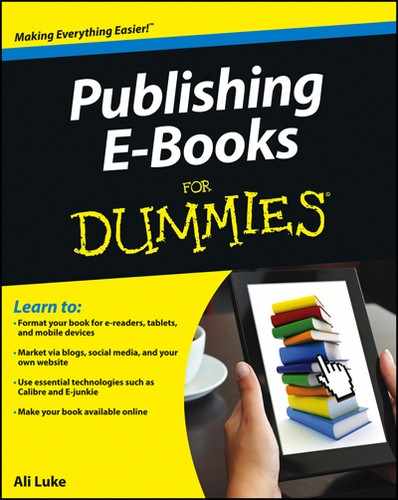Planning and Writing Your Website’s Pages
After your great-looking design is in place, it’s time to think about the basic content of your website. Though the point of a blog-style site, of course, is that you can easily add new posts (dated content) and pages (undated content, usually shown on the navigation menu) over time, you should have basic pages in place from the start.
An About page with details about you and your e-book
When visitors open a website, one of the first things they want to know is what the site is all about, such as who’s behind it and its purpose. An About page answers these questions.
The About page is normally written in the first person, as in “I’m Ali Luke, a writer from Oxford in the United Kingdom,” not “Ali Luke is a writer from Oxford in the United Kingdom.” The About page can include these elements:
![]() Biographical details about you, especially ones that are relevant to your e-book: For example, if you have a relevant qualification or related work experience, that’s definitely worth including — it helps inspire readers’ confidence in your expertise.
Biographical details about you, especially ones that are relevant to your e-book: For example, if you have a relevant qualification or related work experience, that’s definitely worth including — it helps inspire readers’ confidence in your expertise.
![]() Information about your e-book: Not everyone who visits your site will know that you have an e-book for sale. Visitors might find you via a link on Twitter or a search engine such as Google. Don’t go into too much detail about your e-book on the About page, though; save it for a focused sales page.
Information about your e-book: Not everyone who visits your site will know that you have an e-book for sale. Visitors might find you via a link on Twitter or a search engine such as Google. Don’t go into too much detail about your e-book on the About page, though; save it for a focused sales page.
![]() Information about your website: Visitors will want to know what to expect from your site. For example, is it a resource to accompany a particular e-book, or is it a general author site where you have information about multiple e-books? How often will you update it? Where should new visitors begin?
Information about your website: Visitors will want to know what to expect from your site. For example, is it a resource to accompany a particular e-book, or is it a general author site where you have information about multiple e-books? How often will you update it? Where should new visitors begin?
![]() Photographs, images, and video: Some authors feel uncomfortable putting photographs of themselves on the Internet — but if you’re willing to do it, it’s a useful way to establish a stronger connection with visitors. You can even record video of yourself — many web users prefer watching videos to reading text. If you don’t want to post a photo of yourself, you can have a designer create a cartoon-style avatar for you, or you can take photos that relate to the subject matter of your e-book.
Photographs, images, and video: Some authors feel uncomfortable putting photographs of themselves on the Internet — but if you’re willing to do it, it’s a useful way to establish a stronger connection with visitors. You can even record video of yourself — many web users prefer watching videos to reading text. If you don’t want to post a photo of yourself, you can have a designer create a cartoon-style avatar for you, or you can take photos that relate to the subject matter of your e-book.
A sales page for your e-book
On the About page of your e-book, you gently draw people into your website — you don’t want to make them feel pressured into buying your e-book. Create a separate page for information about your e-book, especially if you’re writing nonfiction. I cover sales pages in detail in Chapter 10.
A Contact page so that readers can get in touch
One of the best feelings in the world is receiving an e-mail that says, “I loved your e-book, and thanks so much for writing it!” By including a Contact page on your site, you make it easy for readers to get in touch with you. They might have questions or important feedback that you’ll want to listen to.
Some people put their contact information on the About page of their websites, but I recommend having a separate Contact page to make these details easy to find. After all, it might not be only readers and potential readers browsing your site. What if a busy agent or publisher sees your page and wants to get in touch?
Your e-book’s Contact page should be short and simple. Include, at minimum, your e-mail address. You might also want to add your phone number, particularly if your e-book is part of a larger business for you. Some authors also include their postal addresses. If you’re active on sites such as Twitter or Facebook, you may also want to include links to your profiles there.
